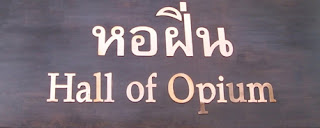 Thailand's new $10m opium museum is a brave attempt to uncover the mysteries of a poppy that has conquered the world. Located near Chiang Rai in the fabled Golden Triangle, a remote and lawless region of South-East Asia, the Hall of Opium will open to tourists later this year. The museum is located in the fabled Golden Triangle
Thailand's new $10m opium museum is a brave attempt to uncover the mysteries of a poppy that has conquered the world. Located near Chiang Rai in the fabled Golden Triangle, a remote and lawless region of South-East Asia, the Hall of Opium will open to tourists later this year. The museum is located in the fabled Golden TriangleBuilt by a royal foundation with Japanese assistance, the museum covers 6,000 square metres (60,000 square feet) on a grassy hillside overlooking the Mekong River.
Visitors enter the museum through a dark, misty tunnel that leads to the first exhibit - a neat flowerbed of red and white poppies. This is where the trail begins, with a plant whose white sap is extracted and boiled to make black opium. Opium has been used as a pain-killer for millennia, and was legally available in many countries until the start of the 20th Century.
As the museum makes clear, the opium trade has long fuelled wars and revolutions, while generating huge profits for merchants and governments around the world. Among the most memorable exhibits is a mock-up of a British clipper ship used to carry opium from India to China, where it was exchanged for tea and other spices.This trade sparked resistance from China's ruling dynasty, which was rudely crushed by British forces in the Opium Wars of the 19th Century.
Opium poppies once grew in the lush fields around the "Hall of Opium", but have mostly been eradicated by decades of crop-substitution projects. Probably the most successful is run by the Mae Fa Luang Foundation, which also designed the museum. Around 10,000 villagers live on its 150 square kilometre (60 square mile) site.
Labels: Chaing Rai - Hall of Opium
0 comments:
Subscribe to:
Post Comments (Atom)